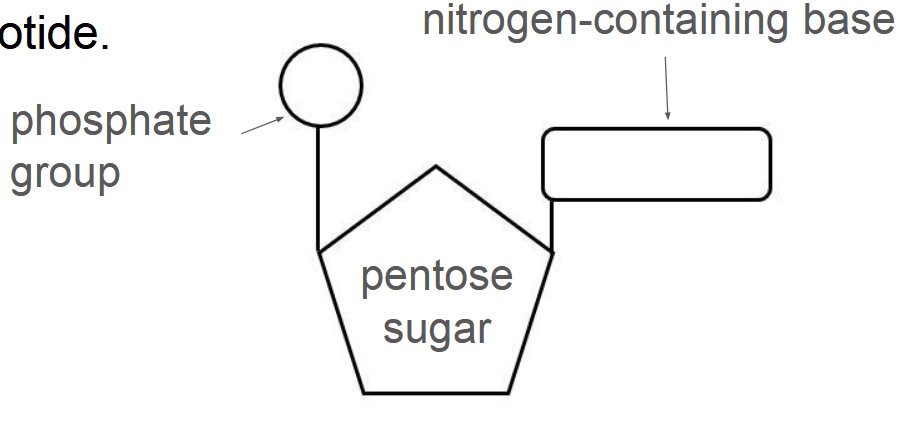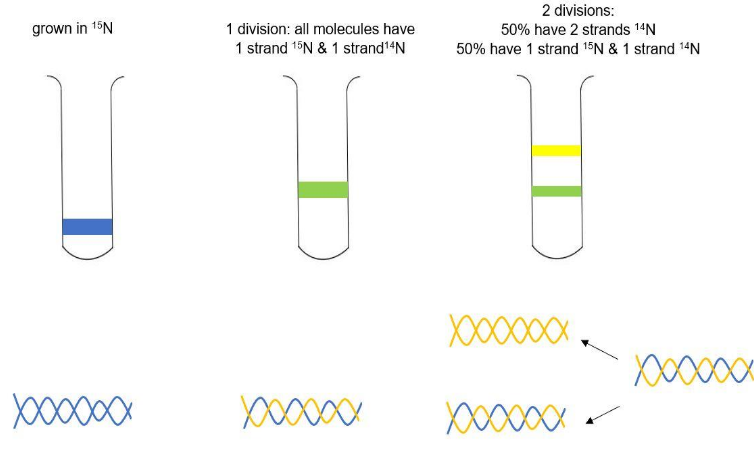1.5 - Nucleic acids 1.6 - ATP
1/22
There's no tags or description
Looks like no tags are added yet.
Name | Mastery | Learn | Test | Matching | Spaced |
|---|
No study sessions yet.
23 Terms
Draw the structure of a nucleotide.

Name the pentose sugars in DNA &
RNA.
DNA: deoxyribose
RNA: ribose
State the role of DNA in living cells.
Base sequence of genes codes for functional
RNA & amino acid sequence of polypeptides.
Genetic information determines inherited
characteristics = influences structure &
function of organisms.
State the role of RNA in living cells.
mRNA: Complementary sequence to 1 gene from DNA
with introns (non-coding regions) spliced out. Codons
can be translated into a polypeptide by ribosomes.
rRNA: component of ribosomes (along with proteins)
tRNA: supplies complementary amino acid to mRNA
codons during translation
How do polynucleotides form?
Condensation reactions between
nucleotides form strong phosphodiester
bonds (sugar-phosphate backbone).
Describe the structure of DNA.
double helix of 2 polynucleotide strands
(deoxyribose)
H-bonds between complementary purine &
pyrimidine base pairs on opposite strands:
adenine (A) + thymine (T)
guanine (G) + cytosine (C)
Which bases are purine and which are
pyrimidine?
A & G = 2-ring purine bases
T & C & U = 1-ring pyrimidine bases
Name the complementary base pairs in
DNA
2 H-bonds between
adenine (A) + thymine (T)
3 H-bonds between
guanine (G) + cytosine (C)
Name the complementary base pairs in
RNA.
2 H-bonds between
adenine (A) + uracil (U)
3 H-bonds between
guanine (G) + cytosine (C)
Relate the structure of DNA to its
functions.
● sugar-phosphate backbone & many H-bonds provide stability
● long molecule stores lots of information
● helix is compact for storage in nucleus
● base sequence of triplets codes for amino acids
● double-stranded for semi-conservative replication
● complementary base pairing for accurate replication
● weak H-bonds break so strands separate for replication
Describe the structure of messenger
RNA (mRNA).
● Long ribose polynucleotide (but shorter than
DNA).
● Contains uracil instead of thymine.
● Single-stranded & linear (no complementary
base pairing).
● Codon sequence is complementary to exons of 1
gene from 1 DNA strand.
Relate the structure of messenger RNA
(mRNA) to its functions.
NB: functions given in same order as related structural feature on
previous slide
● Breaks down quickly so no excess polypeptide forms.
● Ribosome can move along strand & tRNA can bind to
exposed bases.
● Can be translated into a specific polypeptide by
ribosomes.
Describe the structure of transfer RNA
(tRNA).
● Single strand of about 80 nucleotides.
● Folded into clover shape (some paired bases).
● Anticodon on one end, amino acid binding site
on the other:
a) anticodon binds to complementary mRNA codon
b) amino acid corresponds to anticodon
Order DNA, mRNA and tRNA according
to increasing length.
tRNA
mRNA
DNA
Why did scientists initially doubt that
DNA carried the genetic code?
Chemically simple molecule with few
components.
Why is DNA replication described as
‘semiconservative’?
● Strands from original DNA molecule
act as a template.
● New DNA molecule contains 1 old
strand & 1 new strand.
Outline the process of semiconservative
DNA replication.
1. DNA helicase breaks H-bonds between base pairs.
2. Each strand acts as a template.
3. Free nucleotides from nuclear sap attach to exposed
bases by complementary base pairing.
4. DNA polymerase catalyses condensation reactions that
join adjacent nucleotides on new strand.
5. H-bonds reform.
Describe the Meselson-Stahl
experiment.
1. Bacteria were grown in a medium containing heavy
isotope 15
N for many generations.
2. Some bacteria were moved to a medium containing
light isotope 14
N. Samples were extracted after 1 & 2
cycles of DNA replication.
3. Centrifugation formed a pellet. Heavier DNA (bases
made from 15N) settled closer to bottom of tube.
Explain how the Meselson-Stahl
experiment validated semiconservative
replication.

Describe the structure of adenosine
triphosphate (ATP).
nucleotide
derivative of
adenine with 3
phosphate groups
Explain the role of ATP in cells.
Energy released is coupled to metabolic
reactions.
● Phosphate group phosphorylates
compounds to make them more reactive.
ATP hydrolase catalyses ATP → ADP + Pi
How is ATP resynthesised in cells?
● ATP synthase catalyses condensation
reaction between ADP & Pi
● during photosynthesis & respiration
Explain why ATP is suitable as the
‘energy currency’ of cells.
● High energy bonds between phosphate groups.
● Small amounts of energy released at a time =
less energy wasted as heat.
● Single-step hydrolysis = energy available
quickly.
● Readily resynthesised.